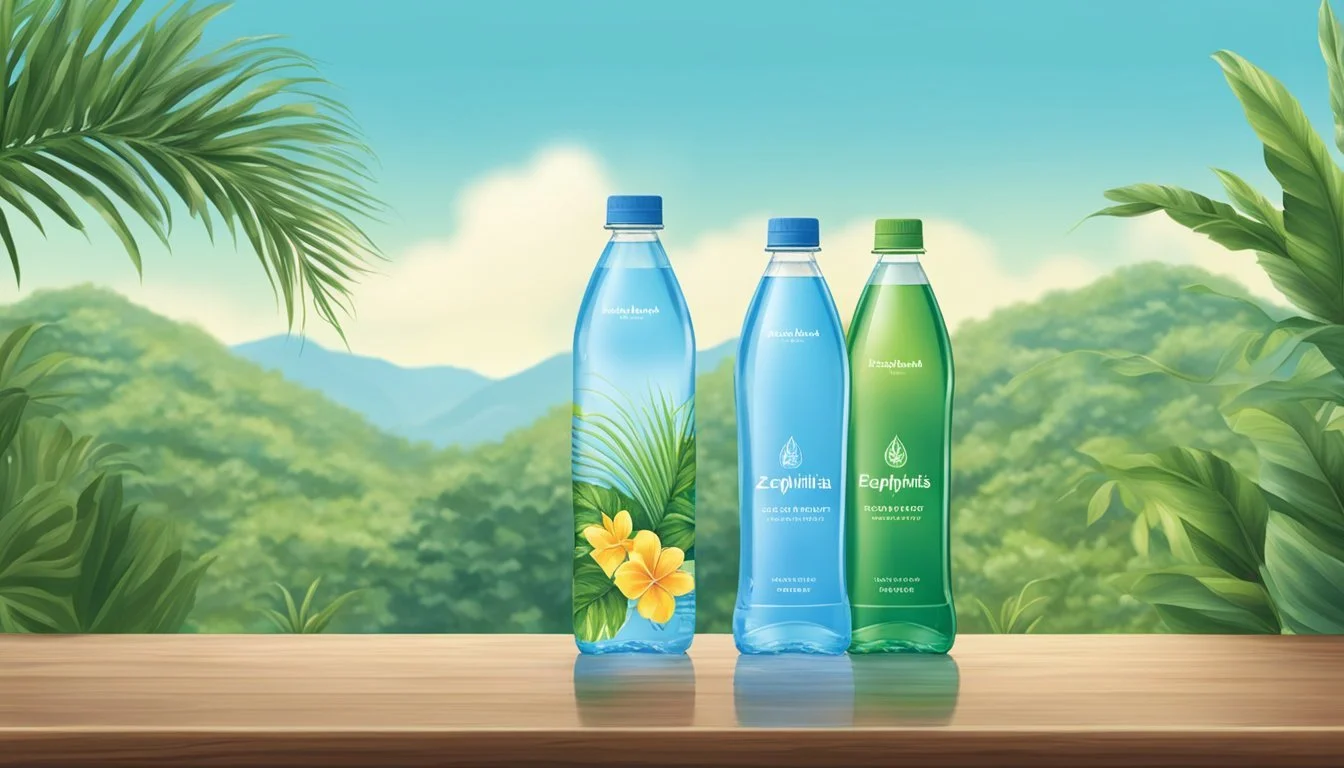Zephyrhills vs. Hawaiian Springs
Comparing Quality and Taste
When it comes to selecting the best bottled water, consumers often find themselves choosing between Zephyrhills and Hawaiian Springs. Zephyrhills, sourced from natural springs in Florida, offers a crisp, clean taste that has made it a favorite among those who prefer a straightforward hydrating experience. On the other hand, Hawaiian Springs boasts a unique, slightly sweet flavor attributed to its source in the volcanic regions of Hawaii, appealing to those who seek a more distinctive taste.
Although both brands have their merits, personal preference plays a crucial role in determining which one stands out. Zephyrhills provides consistency and reliability, making it a solid choice for everyday hydration. Hawaiian Springs, with its exotic origin and unique profile, caters to a niche market of enthusiasts who enjoy the subtleties in their water.
Choosing between Zephyrhills and Hawaiian Springs ultimately comes down to individual taste preferences. For consumers who value crisp and clean water, Zephyrhills is the go-to option. In contrast, those looking for a unique and slightly sweet flavor will find Hawaiian Springs to be an exciting alternative.
Understanding Bottled Water
Bottled water varies greatly in terms of source, purification, and mineral content, which can significantly affect taste, safety, and health benefits. Key aspects include the definition of bottled water, the importance of pH levels, the methods of filtration, and the role of minerals.
Defining Bottled Water
Bottled water comes in several types, each with distinct characteristics. Spring water is sourced from natural springs and usually undergoes minimal processing. Purified water has been processed to remove impurities through methods like reverse osmosis or distillation. Mineral water contains naturally occurring minerals and must meet specific standards. Alkaline water is treated to enhance its pH level, often purported to provide additional health benefits.
The Role of PH in Water Quality
The pH of bottled water affects both taste and potential health benefits. The ideal pH balance for drinking water ranges from 6.5 to 8.5. Alkaline water with a higher pH level is believed to neutralize acid in the bloodstream, though scientific evidence varies. Acidic water below 6.5 pH may lead to potential health risks over time, emphasizing the importance of choosing water within the optimal pH range.
Understanding the Filtration Process
Filtration processes ensure water safety and enhance taste. Common methods include reverse osmosis, which removes contaminants by forcing water through a semi-permeable membrane, and carbon filtration, which adsorbs impurities using activated carbon. Additionally, UV light and ozonation are used to sterilize water without chemicals. High-quality filtration processes significantly reduce total dissolved solids (TDS), improving the water's purity and taste.
Mineral Content and Health Benefits
Mineral content in bottled water can offer various health benefits. Key minerals include calcium, magnesium, and potassium:
Calcium supports bone health.
Magnesium aids muscle and nerve function.
Potassium is essential for heart and kidney function.
Some bottled waters enhance these naturally occurring minerals, promoting them as beneficial for health. Conversely, too many minerals can affect taste and lead to excessive intake, so a balanced mineral content is ideal for most consumers.
Brand Origins and Water Sources
Zephyrhills and Hawaiian Springs each boast distinct origins and water sources that reflect their unique environments. Understanding these differences helps consumers make informed choices.
Zephyrhills: Floridian Heritage
Zephyrhills sources its water from natural springs located in Florida. Specifically, it draws from the Crystal Springs, Cypress Springs, Blue Springs, and other local aquifers. Named after the town of Zephyrhills, this brand highlights the state's abundant fresh water.
The springs are regularly monitored to ensure compliance with health standards. As part of its environmental commitment, Zephyrhills is mindful of sustainable water management practices. These practices maintain the balance of local ecosystems while providing quality spring water.
The brand emphasizes strict quality control, consistently testing its water for purity and safety. This rigorous process ensures that Zephyrhills water meets the high standards expected by consumers.
Hawaiian Springs: Pacific Purity
Hawaiian Springs water is sourced from a single natural spring located on the Big Island of Hawaii. This water is filtered naturally through volcanic rock formations, giving it a unique mineral composition and clean taste.
The spring is situated in one of the most pristine environments on Earth, away from industrial pollutants. Hawaiian Springs capitalizes on the volcanic aquifers' ability to filter and enrich the water, resulting in a crisp, refreshing product.
Environmental considerations are paramount in their operations. Sustainable practices ensure that the water extraction does not harm the local environment or deplete the natural springs. The brand’s commitment to preserving the purity of its water source is reflected in its careful management and quality assurance processes.
Taste Profile and Consumer Preferences
Zephyrhills and Hawaiian Springs have distinct tastes and appeal differently to consumers. Their unique sensory characteristics and consumer preferences set them apart in the bottled water market.
Sensory Characteristics of Water
Zephyrhills is known for its natural spring water sourced from Florida. The water contains naturally occurring minerals that contribute to its slightly sweet and refreshing taste. The pH balance typically ranges between 6.5 and 8.5, ideal for drinking.
Hawaiian Springs water comes from artesian sources in Hawaii. It is noted for its clean, crisp flavor and subtle mineral presence, including electrolytes like calcium and magnesium. This gives it a smooth and soothing mouthfeel, appealing to those who prefer a delicate taste.
Taste Comparison Between Brands
Zephyrhills offers a more straightforward, refreshing flavor due to its natural mineral composition. Consumers often describe it as clean and slightly sweet, making it a popular choice for daily hydration and among those who enjoy a fuller taste profile.
Hawaiian Springs is often praised for its pure, delicate flavor. The water's low mineral content and balanced electrolytes contribute to a smooth and subtle taste. Many consumers favor it for its refreshing quality and the exotic origin, enhancing its premium image.
The differences in mineral composition and source significantly influence the taste and consumer preferences between the two brands. While Zephyrhills appeals to those who enjoy a more robust flavor, Hawaiian Springs attracts consumers seeking a pure and refined drinking experience.
Health and Hydration
When choosing between Zephyrhills and Hawaiian Springs, understanding their composition and health benefits can help make an informed decision. Both brands provide unique features regarding electrolytes and overall health impacts.
Electrolytes and Hydration Efficiency
Zephyrhills: Zephyrhills water is sourced from natural springs and contains naturally occurring minerals, including electrolytes like potassium and magnesium. These minerals are essential for maintaining fluid balance and supporting muscle function. Zephyrhills provides a slight mineral taste, indicative of its natural source.
Hawaiian Springs: Hawaiian Springs also boasts a natural spring source, with a naturally high silica content, contributing to its smooth taste. It contains electrolytes that aid in hydration and fluid balance, making it effective for replenishment post-exercise. Both brands are effective in preventing dehydration, though personal preference in taste may be a deciding factor for many consumers.
Assessing Health Impact
Zephyrhills: Zephyrhills' natural mineral content supports overall health. Consuming water with natural minerals can aid in bone health and cardiovascular function. Additionally, the brand adheres to stringent safety regulations to ensure pure and safe drinking water.
Hawaiian Springs: Hawaiian Springs emphasizes the purity of its water, free from contaminants, ensuring a safe hydration option. It claims a naturally alkaline pH, which some believe supports better health by neutralizing body acidity. The high silica content may also contribute to skin and hair health benefits.
Comparison Table:
Zephyrhills Hawaiian Springs Source Natural spring Natural spring Electrolytes Potassium, Magnesium Silica, other electrolytes Taste Slight mineral taste Smooth and pure taste Health Benefits Bone, cardiovascular health Skin, hair health Safety Strict regulations Pure, contaminant-free
Environmental and Ethical Considerations
Choosing bottled water involves evaluating environmental impact and ethical considerations. Key points include how water is sourced, the sustainability of those practices, and the use of plastic bottles.
Sourcing and Sustainability
Zephyrhills sources its water from natural springs in Florida. The brand emphasizes rigorous purification processes. Hawaiian Springs, on the other hand, prides itself on tapping into artesian wells in Hawaii. Both brands highlight the natural origins of their water.
Sustainability is crucial, as it entails the methods used to extract and maintain water sources without depleting them. Zephyrhills has made efforts to ensure environmentally friendly practices, though scrutiny surrounds plastic pollution. Hawaiian Springs also promotes sustainable sourcing yet faces similar concerns about bottle usage.
Most bottled waters are packaged in plastic bottles. These bottles generate significant plastic waste, which poses a substantial environmental threat. Brands are attempting to use more recyclable materials, but the effectiveness of these measures depends on consumer participation in recycling programs.
Both companies face challenges in balancing the need for clean, bottled water with the pressing need to protect the environment.
Comparing Bottled Water Brands
Various factors contribute to the reputation, quality, and cost-effectiveness of bottled water brands, which can significantly influence consumer choice. Key considerations include brand reputation, water quality, and pricing.
Market Influence and Brand Reputation
Zephyrhills and Hawaiian Springs are well-known in the bottled water industry. Zephyrhills is popular mostly in the eastern United States, while Hawaiian Springs draws from the Hawaiian Islands, appealing to those seeking a unique water source. The prestige of a brand significantly impacts consumer preference.
Other major brands like Fiji Water and Evian also maintain strong market presence due to their extensive marketing campaigns and celebrity endorsements. Brand reputation is often linked to perceived purity and source quality, driving customer loyalty.
Quality Across Popular Brands
Quality is a critical factor when comparing bottled water brands. Zephyrhills sources its water from natural springs in Florida and subjects it to a multi-step purification process. This ensures the water is clean and contains beneficial minerals like calcium and magnesium.
Hawaiian Springs, on the other hand, boasts water that filters naturally through lava rock, adding unique minerals and enhancing its taste profile. Both brands emphasize their natural origins, yet the mineral content and taste may vary, affecting consumer preferences.
Cost-Effectiveness for Consumers
Cost is always a critical factor for consumers. Zephyrhills is typically priced more affordably compared to Hawaiian Springs, making it accessible for a broader audience. Hawaiian Springs, though more expensive, justifies the price with its unique source and exotic appeal.
When evaluating other popular brands like Dasani and Smartwater, cost varies widely. Dasani offers lower prices due to its municipal source and advanced purification methods. Smartwater includes added electrolytes, which increases cost but appeals to health-conscious consumers.
Comparison Table of Costs:
Brand Price ($) per Gallon Unique Selling Points Zephyrhills 1.50 Natural spring water, multi-step purification Hawaiian Springs 3.00 Natural lava rock filtration, unique minerals Dasani 1.00 Purified municipal water, affordability Smartwater 2.50 Vapor-distilled, added electrolytes
In assessing these factors, consumers can make informed choices based on their prioritization of brand reputation, quality, and cost.
Certifications and Industry Standards
Zephyrhills and Hawaiian Springs both prioritize safety and adherence to industry standards. They ensure that their products meet stringent regulations set by agencies like the FDA and EPA.
Safety and Filtration Process
Zephyrhills sources its water from various springs in Florida. Its multi-step filtration process includes carbon filtration and microfiltration, removing impurities and ensuring clean water.
Hawaiian Springs, sourced from Hawaii's Big Island, uses a similar rigorous filtration process, focusing on natural purity and minimal processing.
Industry Certifications
Zephyrhills holds certifications from the NSF International and the International Bottled Water Association (IBWA). This reflects compliance with quality standards and regular testing for contaminants.
Hawaiian Springs also adheres to the IBWA standards and boasts high grades from NSF International. The brand emphasizes eco-friendly practices in its sourcing and bottling.
Transparency and Treatment
Both brands maintain a high level of transparency. Zephyrhills provides detailed water quality reports, listing the source and treatment methods on their labels.
Hawaiian Springs follows suit, offering easy access to water quality information and treatment processes through their website and customer service.
Summary Table
Brand Certifications Filtration Process Transparency Zephyrhills NSF, IBWA Carbon, Microfiltration Detailed reports, labels Hawaiian Springs NSF, IBWA Minimal Processing, Natural Purity Website, customer service
Frequently Highlighted Features
When comparing Zephyrhills and Hawaiian Springs bottled water, it becomes evident that their distinguishing factors lie in their mineral content and pH balance. Understanding these features helps consumers make informed choices.
Natural vs. Added Minerals
Zephyrhills water boasts natural minerals that originate from the springs in Florida. These minerals contribute to a distinct, refreshing taste. Consumers often appreciate the natural sourcing of these minerals.
In contrast, Hawaiian Springs water is also revered for its natural mineral content. The volcanic rocks of Hawaii naturally filter the water, enhancing its mineral profile. There are no added minerals, which means what you taste is entirely natural. This makes Hawaiian Springs unique and a favorite for many.
Alkalinity and PH Balance
When it comes to pH balance, Zephyrhills water typically has a pH that can vary due to its diverse spring sources. The pH can range from slightly acidic to neutral. This variability can affect taste and how the water balances within the body.
Hawaiian Springs water is known for its alkaline nature, often having a pH level around 7.7 to 8.2. This higher pH might appeal to those looking for alkaline water, which some believe helps neutralize acid in the body. The stability of the pH in Hawaiian Springs makes it a consistent choice for those prioritizing alkalinity.
Conclusion
Both Zephyrhills and Hawaiian Springs offer unique attributes catering to different preferences.
Zephyrhills sources its water from natural springs in Florida and contains naturally occurring minerals. This brand is well-regarded for its clean and fresh taste.
Hawaiian Springs prides itself on water sourced from Hawaiian volcanic wells, boasting a naturally alkaline pH range and a distinctive mineral profile.
Feature Zephyrhills Hawaiian Springs Source Florida Springs Hawaiian Volcanic Well pH Range Natural Balance 7.6 to 8.2 (Alkaline) Mineral Content Naturally Occurring Electrolytes and Minerals Taste Clean and Fresh Unique and Distinct
Choice largely depends on personal preference.
Those prioritizing local spring water may lean towards Zephyrhills. Consumers seeking alkaline water with a unique mineral composition might prefer Hawaiian Springs.
Both brands demonstrate a commitment to quality and safety, ensuring the water is clean and beneficial for health.
More About Zephyrhills
Core Hydration vs Zephyrhills: Which Bottled Water is Better?
Icelandic Glacial vs Zephyrhills: Which Bottled Water is Better?
Mountain Valley Spring Water vs Zephyrhills: Which Bottled Water is Better?
Nestle Pure Life vs Zephyrhills: Which Bottled Water is Better?
Poland Spring vs Zephyrhills: Which Bottled Water is Better?
San Pellegrino vs Zephyrhills: Which Bottled Water is Better?
Zephyrhills vs Aqua Carpatica: Which Bottled Water is Better?
Zephyrhills vs Cascade Mountain: Which Bottled Water is Better?
Zephyrhills vs Crystal Geyser: Which Bottled Water is Better?
Zephyrhills vs Hawaii Volcanic: Which Bottled Water is Better?
Zephyrhills vs Kirkland Signature: Which Bottled Water is Better?
Zephyrhills vs Purely Sedona: Which Bottled Water is Better?
Zephyrhills vs Richard's Rainwater: Which Bottled Water is Better?
Zephyrhills vs Solan de Cabras: Which Bottled Water is Better?
Zephyrhills vs Talking Rain AQA: Which Bottled Water is Better?
Zephyrhills vs Whole Foods 365: Which Bottled Water is Better?
Zephyrhills vs Whole Foods Italian Still Mineral water: Which Bottled Water is Better?
More About Hawaiian Springs
Acqua Pana vs Hawaiian Springs: Which Bottled Water is Better?
Aqua Carpatica vs Hawaiian Springs: Which Bottled Water is Better?
Aquafina vs Hawaiian Springs: Which Bottled Water is Better?
Arrowhead vs Hawaiian Springs: Which Bottled Water is Better?
Boxed Water vs Hawaiian Springs: Which Bottled Water is Better?
Castle Rock vs Hawaiian Springs: Which Bottled Water is Better?
Core Hydration vs Hawaiian Springs: Which Bottled Water is Better?
Deer Park vs Hawaiian Springs: Which Bottled Water is Better?
Essentia vs Hawaiian Springs: Which Bottled Water is Better?
Hawaiian Springs vs 1907water: Which Bottled Water is Better?
Hawaiian Springs vs 7-Select: Which Bottled Water is Better?
Hawaiian Springs vs Alkaline88: Which Bottled Water is Better?
Hawaiian Springs vs Antipodes: Which Bottled Water is Better?
Hawaiian Springs vs Big Chill: Which Bottled Water is Better?
Hawaiian Springs vs BodyArmor: Which Bottled Water is Better?
Hawaiian Springs vs Cascade Mountain: Which Bottled Water is Better?
Hawaiian Springs vs CBD Living: Which Bottled Water is Better?
Hawaiian Springs vs Crystal Geyser: Which Bottled Water is Better?
Hawaiian Springs vs Crystal Lake: Which Bottled Water is Better?
Hawaiian Springs vs Essence pH10: Which Bottled Water is Better?
Hawaiian Springs vs Hawaii Volcanic: Which Bottled Water is Better?
Hawaiian Springs vs Kirkland Signature: Which Bottled Water is Better?
Hawaiian Springs vs Liquid Death: Which Bottled Water is Better?
Hawaiian Springs vs Mananalu: Which Bottled Water is Better?
Hawaiian Springs vs Open Water: Which Bottled Water is Better?
Hawaiian Springs vs Proud Source: Which Bottled Water is Better?
Hawaiian Springs vs Pure Life: Which Bottled Water is Better?
Hawaiian Springs vs Purely Sedona: Which Bottled Water is Better?
Hawaiian Springs vs Refreshe: Which Bottled Water is Better?
Hawaiian Springs vs Richard's Rainwater: Which Bottled Water is Better?
Hawaiian Springs vs Simple Truth: Which Bottled Water is Better?
Hawaiian Springs vs Solan de Cabras: Which Bottled Water is Better?
Hawaiian Springs vs Talking Rain AQA: Which Bottled Water is Better?
Hawaiian Springs vs The Well: Which Bottled Water is Better?
Hawaiian Springs vs Tru Alka: Which Bottled Water is Better?
Hawaiian Springs vs Weird Water: Which Bottled Water is Better?
Hawaiian Springs vs Whole Foods 365: Which Bottled Water is Better?
Hawaiian Springs vs Whole Foods Italian Still Mineral water: Which Bottled Water is Better?
Ice Mountain vs Hawaiian Springs: Which Bottled Water is Better?
Icelandic Glacial vs Hawaiian Springs: Which Bottled Water is Better?
Just Water vs Hawaiian Springs: Which Bottled Water is Better?
Mountain Valley Spring Water vs Hawaiian Springs: Which Bottled Water is Better?
Nestle Pure Life vs Hawaiian Springs: Which Bottled Water is Better?
Poland Spring vs Hawaiian Springs: Which Bottled Water is Better?
San Pellegrino vs Hawaiian Springs: Which Bottled Water is Better?
Smartwater vs Hawaiian Springs: Which Bottled Water is Better?
Topo Chico vs Hawaiian Springs: Which Bottled Water is Better?








